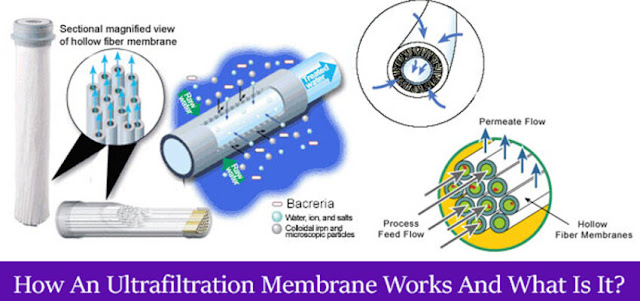How an Ultrafiltration Membrane works and what is it?
Ultrafiltration is an effective water treatment process that utilizes a hollow fiber or a sheet membrane to mechanically filter water containing very small particulate. An Ultrafiltration drinking water system uses this option quality of membrane technology for filtering particulate down to 0.025 microns. To help you get an idea just how small that is, the diameter of a human hair is commonly about 75-80 microns. It means that an Ultrafiltration Plant works on a micro-level, literally taking all suspended solids out of the water.
Ultrafiltration Membrane Filtration
Ultrafiltration Membrane Filtration is a low pressure membrane procedure for water treatment which is designed specifically to eliminate turbidity causing particles including those comprised of the suspended bacteria, solids, colloidal matter, and proteins. The main separation mechanism of Ultrafiltration Membrane Filtration is size exclusion or sieving and the graphic illustrates that Ultrafiltration removes effectively particles in the size range of less than 0.01 to 01 mm. Effective removals of these contaminants in a source water results in a filtrate suitable for further treatment by the downstream reverse osmosis (RO).
The Ultrafiltration procedure is widely used in a vast array of industries and applications as well as typical feed sources that include surface, seawater, well, and wastewaters.
Ultrafiltration Application
The division in pore size and types of particles removed means every type of filtrations serves an aesthetic purposeUltrafiltration is the most advanced filtration process of choice for people who prefer minerals left in their water but still wish microscopic contaminants taken out. An Ultrafiltration system might be chosen over an RO system because it wastes less water to the drain. Someone might select UF in California where water use is regulated. Someone in South Carolina, where the water has some dissolved minerals to start with, might select Ultrafiltration since RO wouldn’t be essential. Sometimes, Ultrafiltration is extensively used to recycle effluent water after filtration, therefore the water can be reused for irrigation purposes.
RO is widely used in situations where all particles consisting of dissolved substances should be stripped from the water. Some people actually prefer RO water from their refrigerator or tap, specifically if they are on well water supply. RO is also favored for the saltwater aquariums, where an exact amount of salt can be added back to the clear water. Nanofiltration is frequently used for removing heavy solids on dairy and for some softening purposes. Microfiltration removes suspended solids like sediment and algae.
Installation of Ultrafiltration system
Ultrafiltration systems are easy to install and this product simply hooks up to a line in the system so that water flows via the filters and the Ultrafiltration membrane. After that, the out-line goes to a faucet. A dedicated faucet is typically suitable to provide the water from the Ultrafiltration system, but it is still easy to install.
How to know when it is time to switch the filter in your Ultrafiltration system?
Ultrafiltration systems commonly come with the carbon filters and it is advisable that you don’t leave your filter in place for longer than one year. There is a gallon capacity rating on most filters, therefore you really don’t want to exceed that. Most hollow fiber membranes can last longer than that, totally depends upon your water quality. However, you have to keep an eye on it and when your water flow starts to slow down, it might be time to replace the membrane.
There are two main types of Ultrafiltration Systems
- Point-of-entry – These are commonly used to run water for applications that don’t require water filtered as fine
- Point-of-Use – These are commonly used for under – the – counter drinking water systems
The membranes in these several systems are going to be configured differently, but they do the same thing. Both systems mechanically filter particulate down to 0.025 microns under the sink. The water filtered through this system flows to a special tap so that just drinking water, or water that would use to make food with, is available through a specified faucet. You don’t need water filtered down to 0.025 microns to rinse your dishes or wash your hands, so that run another faucet. The point-of-entry system processes all the water running into your house and is very good at tannin reduction and removing colloidal suspension.




Comments
Post a Comment